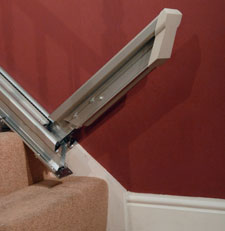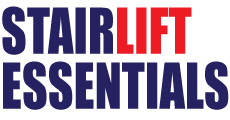What a hinged rail / track on a stairlift is
You may have heard or read about a hinge (or hinged rail/track) on a stairlift. Some stairlifts have one, while others don't. But why?
Below I'll explain what exactly a hinge is, what it is does and why you may need one to fit a stairlift on your staircase.
What is a hinged rail?

Normally, the rail/track of a stairlift is fixed and can't be moved in anyway. But sometimes you can have a small length of the rail/track which can be folded upwards. This length of stairlift rail/track that can folded is called a 'hinge'.
A hinge is always located on the rail/track at the bottom of a staircase (the piece of the rail/track which touches the hallway floor).
Depending on both the model of stairlift you have and the type of hinge (more on that later), when the stairlift is not at the bottom of the stairs or going towards it, the hinged part of rail/track is either folded on top of the fixed rail/track before it or in a position which is above it.
Why a hinged rail is necessary
For safety reasons, a stairlift must always stop a few centimetres above the floor of the hallway at the bottom of the staircase (to allow people to get safely on and off it). To do this, the rail/track of the stairlift needs to extend along the floor of the hallway (around 30cm, but it could be less or more).
On some staircases this can cause a problem. This length of rail/track may obstruct a doorway or access to and from the staircase from the hallway. This creates a big safety risk, because people can trip over the rail/track.
If this is the case, a hinged rail/track should be fitted to the stairlift to prevent this from happening.
On what type of stairlifts
Hinges can be fitted to most models of stairlifts. Although they are most common on stairlifts which have a straight rail/track, they can also be fitted to many models of stairlifts which have a curved rail/track.
Types of hinges
There are two types of hinges that can used on stairlifts:
- A manual hinge
- An automatic hinge (often called a 'powered hinge')
A manual hinge
A manual hinge is where the length of rail/track which is hinged has to be raised or lowered manually (by hand). Watch the video below to see this in action:
An automatic/powered hinge
With a powered/automatic hinge, the hinge is raised/lowered automatically (obviously).Depending on the model of stairlift, the hinge can either be raised/lowered by either pressing a button or (which is increasingly becoming the standard) is done automatically by the stairlift without you having to do anything. Watch the video below to see an automatic hinge in action:
Where the stairlift is parked
If a hinged rail/track is needed on a stairlift, it means you shouldn't leave the stairlift parked at the bottom of the staircase (because it's an obstacle). So on all stairlifts with a hinge fitted, you can park the stairlift when not in use at the top of the stairs and then call it down to the bottom of the stairs when you want to use it. This means that the battery of the stairlift will be being charged (at the charge point) when not in use.
Although you can park the stairlift partially up the staircase on most models of stairlifts, for some models whilst it is parked in this position the battery will not be being recharged. Some models of stairlifts do have a charge point for recharging just above the hinged part of the rail/track, so you can park the stairlift on the staircase near to the bottom and it will recharge.
To find out which models of stairlifts do this, ask the companies you contact about installing a stairlift.
Likely prices
Adding a hinge to a stairlift is going to increase the price you pay for a stairlift. I'm afraid there is nothing you can do about this.
The cost of adding a manual hinge to a stairlift will add £200 or upwards to the final price of the stairlift.
You can at least double that (£400 upwards) for adding an automatic/powered hinge to a stairlift.
Other solutions
Apart from not having a stairlift installed, the only other solution is to have a curved stairlift which parks the stairlift around the side of the staircase at the bottom. Although this solution is possible for most staircases (unless there is very little space around the side), parking a stairlift around the side of a staircase is extremely expensive.
If you have a straight set of stairs, you can at the very least double the final price you pay for stairlift by using this solution. If you already need a curved stairlift it will at least add £1000 on to the final price.
In conclusion
If installing a stairlift causes problems at the bottom of a staircase (e.g. a fixed rail/track obstructs a doorway or access to the staircase) a hinged rail/track is an ideal solution for overcoming these problems. In comparison with the alternative of fitting a curved rail/track which parks the stairlift around the side of the staircase, it is also relatively inexpensive.
In most cases, I would recommend that you choose an automatic/powered hinge over a manual one. If you need a stairlift in the first place, having to manually raise and lower the hinged rail/track is not ideal.
To find out if you need a hinged rail/track for your staircase, you need to get a site visit from one of the reputable companies which sell stairlifts. Until you do, you won't know for certain if you need one.

